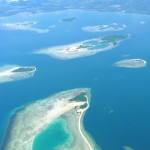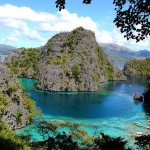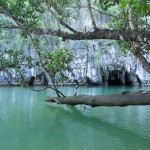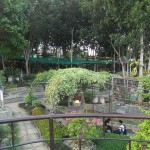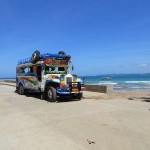Philippine beaches get more than their fair share of media attention worldwide, and rightly so. But this is not even scratching beneath the surface. If the Philippine beaches blow you away, wait until you get underwater to get the full measure of the beauty and bounty of the country.
The Philippine Chapter of Professional Association of Diving Instructors (PADI) recommends the following dive sites as a must for an intrepid underwater explorer:
1) Palawan
Coron Bay, Palawan (Photo by David Spencer)
It does not take a lot of imagination to think of Palawan as the prime dive destination in the country because its beauty on the surface flaunts the Eden below. To be sure, there are several choice dive spots in Palawan, but you will never go wrong if you venture into the Tubbataha Reef National Marine Park first. Cited as a UNESCO World Heritage Site, this underwater constellation of heavenly bodies has also been listed by CNN as one of the world’s top 10 dive sites. Coron not only has achingly beautiful lagoons, it also has an unbelievable diversity that speaks of the preservation efforts of Palawan’s local government and its people. There is a WWII sunken ship in Coron that is easy to explore for beginners. El Nido tantalizes with exotic coral diving, an apt introduction to the ecological state of health of surrounding waters.
2) Puerto Galera
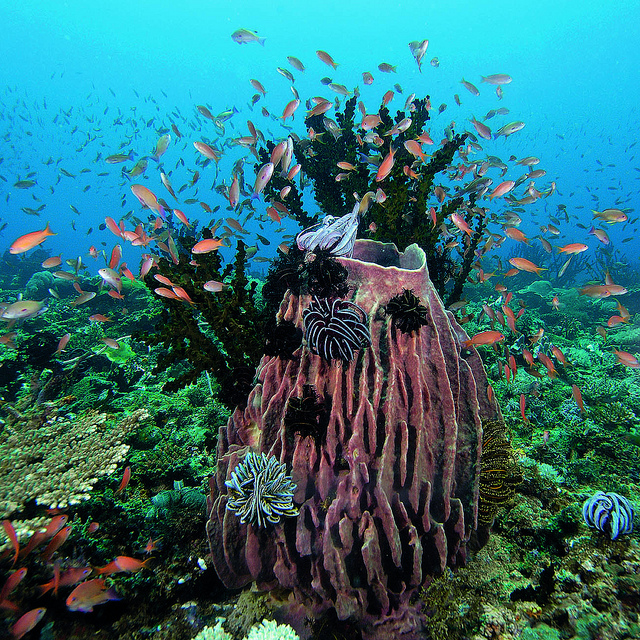
Puerto Galera, Oriental Mindoro (Photo by ASCOM Prefeitura de Votuporanga)
Puerto Galera off the coast of Mindoro (a province adjacent to Palawan) brims with 40 dive sites for divers of all skill levels. The most famous of them all is The Canyons. Snappers, emperors, eagle rays, barracudas, turtles, tuna and occasional sharks are among the denizens of Puerto Galera’s deep.
3) Boracay
Boracay White Beach (Photo by Deortiz)
Not to be outdone by others on the beach list, Boracay promises underwater adventures in the same way it promises fun in the sand. Angol Point just off the coast of Station 3 is a beginner’s dive spot. For the initiated diver, Yapak waters are more challenging and abound with equally rewarding sightings of white-tip and grey reef sharks, tuna, manta rays and eagle rays. The coral canopy is vibrant and populated with corals of all colors and stripes (quite literally).
4) Apo Island
Apo Island (Photo by SarahDepper)
This island off the coast of Dauin has long been in the diving circuit because of its marine wealth and its people’s conservation efforts. Coral gardens are no less breathtaking, and the opportunity for muck diving arises in the waters of Dumaguete, 30 minutes away by boat. (A recent update states, however, that Apo Island’s coral gardens have been affected – well, actually, decimated – by Typhoon Sendong and are presently under rehabilitation.) Those who have frequented Dumaguete waters also know that there are discoveries that wait in the muck. The ecosystem is entirely different and abounds with baskets of sponges, blazing nudibranchs, and colorful crinoids.
5) Malapascua, Cebu
Malapascua, Cebu (Photo by Matt Kieffer)
Cebu is also on the best Philippine beach list, and it is equally flamboyant underwater as it is on the shore. Hammerhead sharks have been spotted to patrol the waters from December to February, but Monad Shoal abounds with creatures of all imaginable kinds year round. Diving is also friendlier, because the less intrepid can just skim the surface at 5 meters and get generously rewarded with astounding sights.
6) Subic Bay
Subic Bay (Photo by allan piamonte)
More famously known as the United States’ Naval base in the Pacific until the Philippine Senate voted against it, Subic Bay not only beckons with marine denizens but also with interesting finds. Sharks, dolphins, turtles and barracudas flit in and out of Subic waters along with WW II wrecks.
7) Cauayan-Sipalay-Hinobaan Circuit, Negros Occidental
Sulu Sea (Photo by Jayvee Fernandez)
The adventure starts at Danjugan Island just off the coast of Cauayan, a town that precedes Sipalay in Southern Negros. Danjugan is a marine reserve and a living laboratory for WWF (World Wildlife Fund) marine biologists. Additionally, the island’s relative isolation from the mainland has helped maintain the health of marine life. From here further down south, it only gets better. Coral gardens abound in shallower waters until Nabulao Bay in Hinobaan, the last town of Negros Occidental, where another island known in the map as Pitogo but known by the locals as “pulo” (isle), hosts natural growth mangrove forests and a very expensive tropical resort. This tri-town circuit directly faces Sulu Sea, so gigantic bivalve mollusks, 150-pound yellowfin tunas and bottlenose dolphins are typical sightings.
Technically a snorkeling, instead of diving, destination, Donsol in Sorsogon rewards the marine adventurer with almost year-round sightings of the whale sharks locally known as the “butanding.” Before whale shark overdose sets in, however, divers can explore Manta Bowl and Ticao Island of nearby Masbate, where marine wildlife is said to be unbelievably diverse and colorful.
Explore the rest of the world
More from my site
Article by Chris
Chris had a passion to contribute to society especially to fellow travelers like himself. He also had a passion for Southeast Asia and frequently visited. While brainstorming ideas, he decided that a travel blog dedicated to his favorite countries, Thailand and Singapore, could be more beneficial than any guidebook. Only one year later did the blog’s success bring in more writers, more countries, and more readers.
- Google+ |
- More Posts (327)
Help others get the information they need by liking or sharing our page!
Follow @followloveblab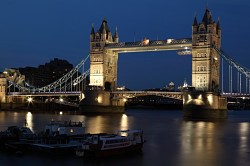 Discover marvelous architecture in London
Discover marvelous architecture in London